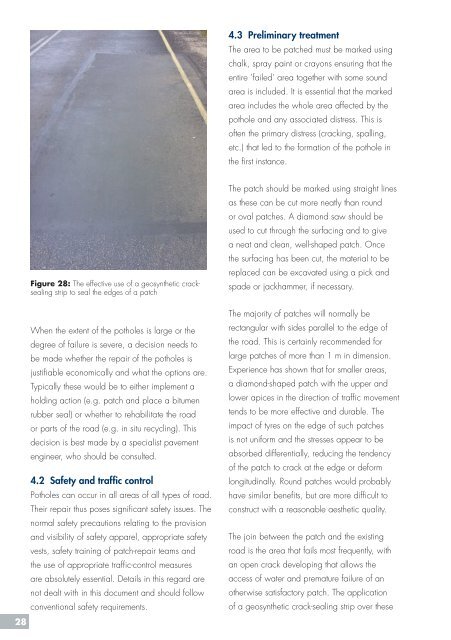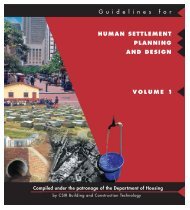POTHOLES: - CSIR
POTHOLES: - CSIR
POTHOLES: - CSIR
- No tags were found...
You also want an ePaper? Increase the reach of your titles
YUMPU automatically turns print PDFs into web optimized ePapers that Google loves.
4.3 Preliminary treatmentThe area to be patched must be marked usingchalk, spray paint or crayons ensuring that theentire ’failed’ area together with some soundarea is included. It is essential that the markedarea includes the whole area affected by thepothole and any associated distress. This isoften the primary distress (cracking, spalling,etc.) that led to the formation of the pothole inthe first instance.28Figure 28: The effective use of a geosynthetic cracksealingstrip to seal the edges of a patchWhen the extent of the potholes is large or thedegree of failure is severe, a decision needs tobe made whether the repair of the potholes isjustifiable economically and what the options are.Typically these would be to either implement aholding action (e.g. patch and place a bitumenrubber seal) or whether to rehabilitate the roador parts of the road (e.g. in situ recycling). Thisdecision is best made by a specialist pavementengineer, who should be consulted.4.2 Safety and traffic controlPotholes can occur in all areas of all types of road.Their repair thus poses significant safety issues. Thenormal safety precautions relating to the provisionand visibility of safety apparel, appropriate safetyvests, safety training of patch-repair teams andthe use of appropriate traffic-control measuresare absolutely essential. Details in this regard arenot dealt with in this document and should followconventional safety requirements.The patch should be marked using straight linesas these can be cut more neatly than roundor oval patches. A diamond saw should beused to cut through the surfacing and to givea neat and clean, well-shaped patch. Oncethe surfacing has been cut, the material to bereplaced can be excavated using a pick andspade or jackhammer, if necessary.The majority of patches will normally berectangular with sides parallel to the edge ofthe road. This is certainly recommended forlarge patches of more than 1 m in dimension.Experience has shown that for smaller areas,a diamond-shaped patch with the upper andlower apices in the direction of traffic movementtends to be more effective and durable. Theimpact of tyres on the edge of such patchesis not uniform and the stresses appear to beabsorbed differentially, reducing the tendencyof the patch to crack at the edge or deformlongitudinally. Round patches would probablyhave similar benefits, but are more difficult toconstruct with a reasonable aesthetic quality.The join between the patch and the existingroad is the area that fails most frequently, withan open crack developing that allows theaccess of water and premature failure of anotherwise satisfactory patch. The applicationof a geosynthetic crack-sealing strip over these

















